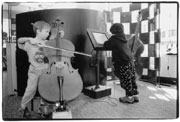ASK ANY CLASSICAL music fan where their first exposure to it came from; if it wasn’t picked up at home from their parents, they likely got it through private lessons or school performing ensembles. But now that classical music’s been losing whatever place it once had in the public school curriculum, musical organizations have begun to step in, giving more effort to education and trying to fill in the exposure gap with their own outreach programs.
The Seattle Symphony’s solution, intended both to encourage new listeners and deepen the engagement of current classical devotees, is “Soundbridge: Seattle Symphony Music Discovery Center,” a $6.4 million music education center. Heading up the project is SSO’s director of education and community programs, Patricia Costa Kim. Opening April 17 in the Second and Union corner of Benaroya Hall (where it offers the only public access to the building not commercial in intent), it’s a handsome space, full of vivid, elegant graphic design and warm light wood similar to that in Benaroya’s two performance halls.
Five “listening bars” greet you as you enter: spaces to sample, via headphones and a touch-screen menu, a recording library of more than 500 orchestral works from all periods, including all the SSO’s CDs and the repertory from the current season. Other stations introduce you to composers, conductors, and the instruments of the orchestra, with video interviews with SSO musicians (the SSO’s guest soloists, too, will be invited to contribute interviews to the library) and hands-on instrument tryout opportunities. The spokesperson for the string section, for example, is SSO principal violist Susan Gulkis, who chats informatively about the pleasures and challenges of an orchestral career. A nearby headset invites you to sample the viola’s sound, with recordings (chosen by Gulkis) of its use as a solo, chamber music, and concerto instrument, as well as an example of an orchestral viola section in action.
In the “Symphonic Music Lives” exhibit, a ceiling-mounted speaker showers you with music, providing examples of orchestral sounds used in the familiar contexts of film and TV. (Raise your hand if you first heard Wagner or Rossini via Bugs Bunny.) The coolest exhibit of the lot is the “Virtual Conductor”: A six-foot-high hemispherical screen shows a close-up video of the orchestra playing, giving you a Gerard Schwarz-eye view of a rehearsal.
THE OTHER HALF of Soundbridge’s 2,000-square-foot space is a lovely pocket-size auditorium, seating about 80, with a stage area backed by striking red-stained wooden panels. This will be used for lectures, discussions, master classes, and informal performances of all kinds. SSO rehearsals can be watched here via high-definition TV—and teachers and students will be able to discuss the proceedings without worrying about their conversation being disruptive. In this space is another interactive exhibit exploring acoustics, plus computer games enabling you to build and play back rhythms and melodies. All this technical stuff was set up by a team from Microsoft, including the Windows Media system that organizes Soundbridge’s video and audio files and enables the digital storage and compression of their entire library. Geordie Wilson, product manager for Microsoft’s Digital Media Division, said that “one of the design goals [for the center’s hardware] was to keep it flexible.” This will allow for the next phase of user interactivity: The Soundbridge staff plans to launch an investigation into the deliverability of the Soundbridge experience on the World Wide Web, in the hope of enabling Internet access to their music and interview library.
The concert experience unfortunately but necessarily reinforces the distinction between active music-makers and passive listeners, but with its interactive exhibits, Soundbridge—just as its name suggests—blurs this line. Here, music is not only a spectator sport. The whole center is highly kid-friendly, but it’s meant for all ages, with programs and activities designed for toddlers, schoolkids, teachers, concert novices, and practicing musicians of all levels. Think of it as a sort of classical EMP—but rather than presenting a historical overview, Soundbridge focuses on orchestral music-making as an activity of the here-and-now.
The space seems well designed to make symphonic music less forbidding while conveying its wonder, power, and sheer fun. And this sort of demystification is just what the art form needs. Lots of theories have been advanced as to why classical music no longer holds quite as high a profile in our culture as it used to. (It’s a popular topic for music-critic think pieces—and understandably so; the headline “Classical Music Is Healthy and Flourishing” would sell no papers.) Everyone from Schoenberg to Pavarotti has been blamed, but the truth is that people’s fears about classical music keep them out of concert halls just as effectively as the realities of complex music or inflated ticket prices.
Look behind the high-tech gloss of Soundbridge and you’ll see these prejudices subtly debunked. Elitist? Not a bit; instead, the center sends the message that the classical music world is populated by people who work for a living, by women and minorities, by kids, all of whom have discovered—or are still discovering—that symphonic music is not something remote, historical, and foreign, but a rich and vital part of everyday life.
Soundbridge opens to the public April 17. Tue-Sun, 10 a.m.-6 p.m. $7 adults/$5 children; $20 individual annual membership. Schedule of classes and workshops TBA.







